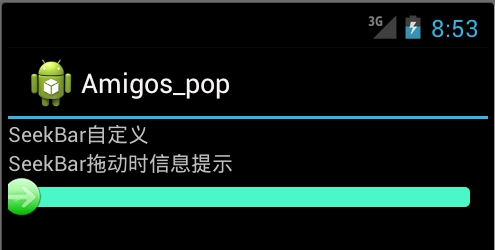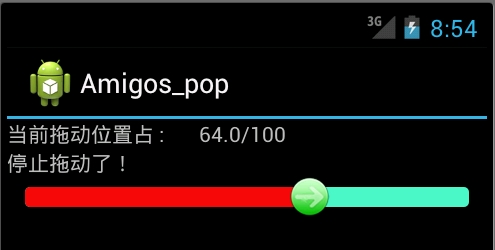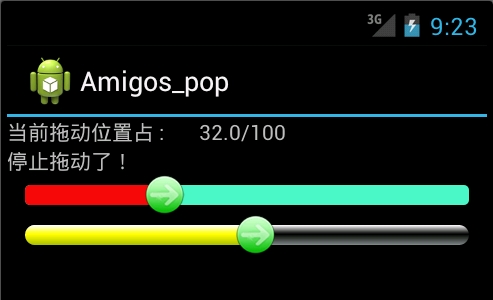案例使用的图片如下:
1.在res/drawable目录下新增一个xml风格文件,seekbar_define_style.xml
|
1
2
3
4
5
6
7
8
9
10
11
12
13
14
15
|
<?xml version="1.0" encoding="utf-8"?><layer-list xmlns:android="http://schemas.android.com/apk/res/android"> <!-- 未选中 --> <item android:id="@android:id/background" android:drawable="@drawable/hou"/> <!-- 中 --> <item android:id="@android:id/progress" android:drawable="@drawable/qian"/> <item android:id="@android:id/secondaryProgress" android:drawable="@drawable/qian"/></layer-list> |
2.在res/drawable下定义个seekbar_thumb.xml文件
|
1
2
3
4
5
6
7
8
9
10
11
12
13
14
15
16
17
18
19
20
21
22
23
|
<?xml version="1.0" encoding="utf-8"?><selector xmlns:android="http://schemas.android.com/apk/res/android"> <!-- 按下状态--> <item android:state_focused="true" android:state_pressed="true" android:drawable="@drawable/ic_launcher" /> <!-- 普通无焦点状态 -拖动按钮--> <item android:state_focused="false" android:state_pressed="false" android:drawable="@drawable/orbino_icon_pack_006" /> <!-- 有焦点状态--> <item android:state_focused="true" android:state_pressed="false" android:drawable="@drawable/ios" /> <!-- 有焦点 --> <item android:state_focused="true" android:drawable="@drawable/ios"/></selector> |
3.在res/layut下定义布局资源文件seekbar_define.xml
|
1
2
3
4
5
6
7
8
9
10
11
12
13
14
15
16
17
18
19
20
21
22
23
24
25
26
27
28
29
30
31
32
33
34
35
36
|
<?xml version="1.0" encoding="utf-8"?><ScrollView xmlns:android="<a href="http://schemas.android.com/apk/res/android" rel="nofollow">http://schemas.android.com/apk/res/android</a>" android:layout_width="fill_parent" android:layout_height="fill_parent" > <LinearLayout android:layout_width="fill_parent" android:layout_height="fill_parent" android:orientation="vertical" > <TextView android:id="@+id/seekbar_tetview_one" android:layout_width="wrap_content" android:layout_height="wrap_content" android:text="SeekBar自定义" /> <TextView android:id="@+id/seekbar_tetview_two" android:layout_width="wrap_content" android:layout_height="wrap_content" android:text="SeekBar拖动时信息提示" /> <SeekBar android:layout_width="321px" android:layout_height="wrap_content" android:layout_centerInParent="true" android:maxHeight="20px" android:minHeight="20px" android:paddingLeft="18px" android:paddingRight="18px" android:max="100" android:progressDrawable="@drawable/seekbar_define_style" android:thumb="@drawable/seekbar_thumb" android:id="@+id/seekBar"/> </LinearLayout></ScrollView> |
4.定义java文件通过 引用布局文件:
|
1
2
3
4
5
6
7
8
9
10
11
12
13
14
15
16
17
18
19
20
21
22
23
24
25
26
27
28
29
30
31
32
33
34
35
36
37
38
39
40
41
42
43
44
45
46
47
48
49
50
51
52
53
54
55
56
57
58
59
60
61
62
63
64
65
66
67
68
69
70
71
72
73
74
75
76
77
78
79
80
81
82
83
84
85
86
|
package com.test;import android.R.integer;import android.app.Activity;import android.os.Bundle;import android.os.Handler;import android.os.Message;import android.widget.SeekBar;import android.widget.SeekBar.OnSeekBarChangeListener;import android.widget.TextView;public class SeekBarDemo_DefineDemo extends Activity { private SeekBar seekBar; private TextView textView_one, textView_two; @Override protected void onCreate(Bundle savedInstanceState) { super.onCreate(savedInstanceState); setContentView(R.layout.seekbar_define); seekBar = (SeekBar) findViewById(R.id.seekBar); textView_one = (TextView) findViewById(R.id.seekbar_tetview_one); textView_two = (TextView) findViewById(R.id.seekbar_tetview_two); seekBar.setOnSeekBarChangeListener(seekbarChangeListener); } private OnSeekBarChangeListener seekbarChangeListener = new OnSeekBarChangeListener() { // 停止拖动时执行 @Override public void onStopTrackingTouch(SeekBar seekBar) { // TODO Auto-generated method stub textView_two.setText("停止拖动了!"); } // 在进度开始改变时执行 @Override public void onStartTrackingTouch(SeekBar seekBar) { // TODO Auto-generated method stub textView_two.setText("进度开始改变"); } // 当进度发生改变时执行 @Override public void onProgressChanged(SeekBar seekBar, int progress, boolean fromUser) { textView_two.setText("正在进行拖动操作,还没有停下来一直再拖动"); Message message = new Message(); Bundle bundle = new Bundle();// 存放数据 float pro = seekBar.getProgress(); float num = seekBar.getMax(); float result = (pro / num) * 100; bundle.putFloat("key", result); message.setData(bundle); message.what = 0; handler.sendMessage(message); } }; /** * 用Handler来更新UI */ private Handler handler = new Handler() { @Override public void handleMessage(Message msg) { textView_one.setText("当前拖动位置占 : " + msg.getData().getFloat("key") + "/100"); } };} |
最后执行效果:
二:使用颜色显示,和尚面是一样的,只有我们定义颜色资源来替代图片资源文件seekbar_define_color_style.xml:如下:
|
1
2
3
4
5
6
7
8
9
10
11
12
13
14
15
16
17
18
19
20
21
22
23
24
25
26
27
28
29
30
31
32
33
|
<?xml version="1.0" encoding="UTF-8"?> <layer-list xmlns:android="http://schemas.android.com/apk/res/android"> <item android:id="@android:id/background" android:paddingTop="3px" android:paddingBottom="3px"> <shape> <corners android:radius="10dip" /> <gradient android:startColor="#ffffffff" android:centerColor="#ff000000" android:endColor="#ff808A87" android:centerY="0.45" android:angle="270"/> </shape> </item> <item android:id="@android:id/progress" android:paddingTop="3px" android:paddingBottom="3px" > <clip> <shape> <corners android:radius="10dip" /> <gradient android:startColor="#ffffffff" android:centerColor="#ffFFFF00" android:endColor="#ffAABD00" android:centerY="0.45" android:angle="270"/> </shape> </clip> </item> </layer-list> |
之后再SeekBar标签使用如下属性进行引入:其他保持不变
|
1
|
android:progressDrawable="@drawable/seekbar_define_color_style" |
执行效果:
由于SeekBar的属性thumb引入了自定义的seekbar_thumb.xml文件,拖动图标是我们自定义的图片:除去这个属性
|
1
|
android:thumb="@drawable/seekbar_thumb" |
就回复系统默认状态效果最后效果如下:
我们可以通过颜色值再次休息seekbar_thumb.xml文件,使拖动按钮设置成自定义颜色:







